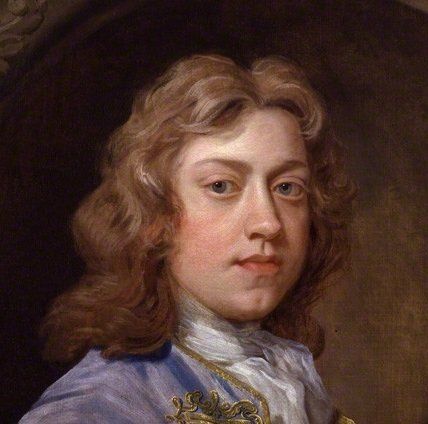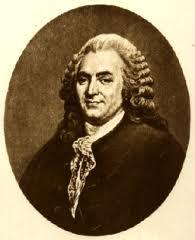Portrait of Bernard Mandeville
On March 4th, 2009, we encountered by chance a portrait, which immediately struck us because of its resemblance to the two images of Mandeville, which we had known for many years. The shock of recognition lead to an article ‘Dat moet portret Mandeville zijn' in the Dutch newspaper Trouw (12-03-2009). The portrait is in the National Portrait Gallery in London, nr 1261. Its artist is John Closterman (1660-1711). The painting is dated between 1702-1705. See NPG. As for James Thornhill (1675-1734), father-in-law of Hogarth, mentioned on the NPG website, see Wikipedia. See also NPG, Beningbrough Hall, Saloon. An interesting link concerning ‘Kloosterman' - in Dutch - is by Jacob Campo Weyerman, in Konstschilders
(1729).
This is what Bernard Mandeville looked like!
Two images (woodcuts) of Mandeville, originally having a much smaller size, are located in printer ornaments of Mandeville’s Free Thoughts on Religion, the Church and National Happiness, edition 1720. We think that the first one (below) was made after the NPG portrait, dated about 1702-1705. The second one may be dated later, just before the year 1720.
The visual research tool of Hazel Wilkinson's Compositor, the database of eighteenth-century printers' ornaments (https://compositor.bham.ac.uk), shows that both human faces in profile are unique, and not to be confused with any other.
Provenance of the portrait NPG 1261, an ongoing research project
Here we will report progress in the project of defining the identity of the sitter in this portrait, whom we believe to be Bernard Mandeville, until, of course, we’ ll find evidence to the contrary. Any help in this research project would be very much appreciated. Next we present the information we have got so far. Will it ever be possible to find out with certainty whether it would be the sitter in this portrait is Bernard Mandeville? One way of research is to discover its provenance.
1. What we do know is the provenance for NPG. This is stated to be the London art trade in 1900. Previously it had possibly been in the hands of Thomas Hamlet (1770-1853), the famous goldsmith and trader. For the portrait is cited in the catalogue of John Closterman’s work, by Malcolm Rogers in the 49th Walpole Society volume 1983, p. 267. And Rogers states that inscribed on the portrait’s stretcher in a mid-nineteenth-century hand is ‘Portrait of Sir James Thornhill Painted by Imself Late the Property (of) Mr Hamlet’. But this portrait is not identifiable in any of Hamlet’s sales, 1833-41. James Thornhill (1675-1734), father-in-law of William Hogarth, is certainly not the sitter.
2. In 1899 the Wellcome Library in London purchased a manuscript (MS 3415) by Michael de Mandeville (1639-1699), the father of Bernard Mandeville. It contains ‘Notes of lectures at the Universities of Franeker and Nijmegen on the Institutes of Medicine, and on Cartesian Philosophy: in Latin. Holograph MS. by de Mandeville, written while a medical student.’ This manuscript must also have been in Bernard Mandeville’s estate, that was split up (see below). As for its provenance, we quote from Wellcome Library’s entry:- Early 19th cent. vellum binding. Margins slightly cropped in binding. The fly-leaves are watermarked 1824. - Signature of John Lee [1783-1866], antiquarian and scientist '. J. Lee Doctors Commons No. 390. Recovered Mr Wilson, London'.
3. The Hunterian Library of the University of Glasgow holds some books once possessed by Michael de Mandeville (father or great-grandfather), which must have been in Bernard Mandeville’s library. This collection was assembled by Dr William Hunter (1718-1783) and remained in London after his death - for the use of his nephew, Dr Matthew Baillie (1761-1823) - and finally came to the University in 1807.
4. Bernard Mandeville died in January 1733 (O.S.), his wife in April 1732. Michael Mandeville (1699-1769), their son, was the executor of Bernard Mandeville’s will. Michael Mandeville died childless. We don't know anything about him, except for a letter of Bernard Mandeville to his friend Lord Macclesfield, dealing with Michaels health problems.
From Michael's will we know his executors: Jeremiah Wilder, confectioner, of Cheapside, and John Elliott of Kennington Lane. When Michael Mandeville died, he dwelled with Elliott in Elliott’s house. Supposing that Michael Mandeville kept both his father’s portrait and library, it may be inferred from his will that they would have belonged to the goods that Michael Mandeville bequeathed to the said Elliott.
5. Now, in 2024, we return to Thomas Hamlet, whom we mentioned at the beginning. The Sotheby's publication Treasures, (London, July 4, 2018), pp. 260-5 discusses in detail the silversmith William Elliott (1773-1855) and the goldsmith and trader Thomas Hamlet. Separately, but also in their business relationship. William Elliott was the eldest child of William Elliott and his wife Rebecca.
6. Bearing in mind the connection between Thomas Hamlet and this Elliott family, and the first name 'John' not being uncommon in it, we might suppose that John Elliott of Kennington Lane was somehow related to these Elliotts. This suggestion could be further investigated.
7. But thinking of a medical connection, we might think of a link between Michael Mandeville and John Elliott (1747-1787). Much younger than Michael Mandeville, Elliott (or Elliot), son of a clothier at Chard in Somersetshire, was put apprentice to Mess. Smith, apothecaries, of Cheapside. He worked as an apothecary, obtained a degree of M.D and became an author. Elliott was a man of 'very considerable talents ', who 'procured for himself very large emoluments'. He lived at various addresses in London.
Elliott may supposed to have been very interested in what Bernard Mandeville had left to his son Michael.
On the 2nd of July 1787, Elliott was detained at Old Bailey, because of his firing a pistol at Miss Mary Boydell (1747-1820), niece and business-partner of Alderman John Boydell (1720-1804). In prison Elliott 'destroyed himself by an obstinate refusal of all food.' He was buried in Paddington, July 26.
Due to this well-known fateful event the name of the sitter on the portrait, if in possession of Elliott, is missing. Who handled Elliott's inheritance?
8. It should be noted that a portrait of an unknown or, if recognized, an unloved sitter, like e.g. Bernard Mandeville, was not valuable, and hardly suitable for auctions. At least, if we judge from the very low price of £ 2 and 10 shillings, paid by Alderman John Boydell (we mentioned before), for the now
missing portrait of Sir James Thornhill, which is lot 43 in 'Mrs. Hogarth's Collection' (auction on 24-04-1790). Source: The Burlington Magazine for Connoisseurs, Oct., 1944, Vol. 85, No. 499 (Oct., 1944), pp. 237-239. But the mid-nineteenth-century attribution to Sir James Thornhill (see point 1) may have been a name mistake that had already been made in 1790. Thus it could be the portrait we believe to be Bernard Mandeville's.






